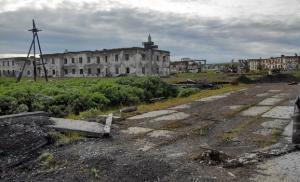And again - the world's largest container ship "MSC Oscar". The largest cargo ship in the world - container ship Emma Maersk
Today, ninety-five percent of all cargo is carried by sea.Container shipsare relatively young types of ships. With an average age of 10 years, "Emma Maersk"considered the youngest among the restcontainer ships of such a type.
Emma
Maersk
- the present modern miracle. It is the longest container ship currently in service and is powered by the largest diesel engine ever produced.
Emma Maersk is the first E-class container ship out of 8, owned by the company A.P. Moller-Maersk Group. When launched in 2006, Emma Maersk was the largest container ship ever built. In 2010, the ship and 7 other ships in the series became the longest container ships ever built in the world and the longest ships in use at that time, after the world's largest ship, the Seawise Giant, was permanently docked in 2004 , was scrapped in 2010.
Officially, Emma Maersk can carry up to 11,000 TEU or 14,770 TEU depending on the load capacity determination method. Maersk initially reported the vessel's cargo capacity at 11,000 TEU, according to the company's own method of calculating cargo capacity at the time, which was 1,400 more containers than any other vessel when the vessel was put into service. However, the company also admits that using the standard method of calculating capacity, Emma Maersk can take on board up to 14,770 TEU.

In normal calculations, Emma Maersk has a significantly higher carrying capacity than these figures, from 13,500 to 15,200 TEU. The difference arises because Maersk's official figures are based on the weight of containers, while other companies estimate a ship's capacity based on the maximum number of containers that can be carried on board, regardless of their weight. This number is always higher than Maersk's estimates.

According to AP Moller, the company that owns Maersk Lines, a typical 20-foot container can hold an average of 48,000 bananas. Therefore, in theory, Emma Maersk could carry about 528 million bananas - enough to give every person in Europe or North America banana for breakfast.

The container ship Emma Maersk became the first ship new series large-tonnage vessels with a highly automated control system. It is equipped with modern computer systems to ensure efficient functioning. The general interior of the cargo ship is made of materials highest quality. Appearance The ship is a design typical of container ships that are built at the Odense Steel Shipyard Ltd.

The container ship "Emma Maersk" was named "Ship of the Year" at the presentation in 2007 in London, organized by the popular magazine Lloyd's List in Europe. The creators, during the construction of this transport vessel, set new standards in protection environment and safety, as well as efficiency, which is so important when transporting various goods. These include an exhaust gas recirculation system, which made it possible to reduce the emission of harmful substances into the atmosphere and, as a result, the power of the power plant increased and fuel consumption decreased. Another innovation was the vessel's hull treated with a special silicone coating, which led to an unexpected result - by reducing water resistance, fuel costs decreased by 1,200 tons per year.

The cargo ship can accommodate 13,500 containers, instead of the planned 11,000. This is possible thanks to its excellent seaworthiness and 22 sections on board. The container ship is always a welcome guest in the ports of Bremerhaven, Rotterdam, Los Angeles, Gottenburg, Argus, Ningbo, Xiamen and Tanjung Pelepas.

After completion of construction, the ship set off on its first voyage.
The ship was solemnly presented at a ceremony on August 12, 2006. Emma Maersk got its name from Emma, the wife of Maersk McKinney Moller. The ship set off on its maiden voyage on September 8, 2006 at 2:00 am from Aarhus, calling at Gothenburg, Bremerhaven, Rotterdam, Algericas, Suez Canal and arrived in Singapore on October 1, 2006 at 20-05.
The ship appeared in the news before Christmas 2006, called the SS Santa, as the ship was heading from China to the UK with a cargo of gifts for the holiday. On the return voyage after Christmas 2006, the ship returned to South China with a cargo of waste from the UK intended for recycling.

Environmental safety is achieved on the ship thanks to a heat capture system, which helps save up to 10% of energy. But more importantly, because the ship is three times the size of any container ship that has sailed through the Panama Canal, the number of small ships it could displace would produce far more emissions than a single large ship.
Despite this, the Emma Maersk and others like it have been criticized for burning bunker fuel, which has a high sulfur content. The sulfur content in ship fuel is 2.5-4.5%, which is 2000 times higher than what is allowed in automobile fuel.
By the way, despite its gigantic size, the ship’s crew is only 13 people.

The Emma Maersk container ship can be loaded with twenty giant cranes simultaneously. The average container ship can carry a thousand twenty-foot containers, while the Emma Maersk cargo ship has a capacity of 13,500 TEU (twenty-foot equivalent). This is almost 4,000 more containers than the previous leader, Xin Shanghai. average cost a container ship with a capacity of 4,000 TEU is $61 million, 8,000 TEU is $116 million.

The container ship Emma Maersk is impressive. This is the largest container ship in the world. Each loaded shipping container is the size of a trailer. There are fewer containers on the deck of a cargo ship; most of them are located in the hold. If all the shipping containers were unloaded from the deck of a container ship, it would fit two space shuttles. Proper loading is an art for everything from toys to cars.

There are basic rules for handling cargo: to keep the container ship stable, the heaviest shipping containers are placed at the bottom; dangerous goods and flammable mixtures are on deck, since no one wants an explosion in the hold. If more than seven rows of sea containers are placed in front of the navigation bridge, then the captain of the container ship will not see anything. Too many or few containers in the center will affect the draft of the cargo ship. All these rules apply before the start of sailing. Rough seas, changeable currents and winds, all these factors make shipping containers a dangerous business with the possibility of colossal losses. You always need to adhere to a busy schedule and certain rules.
The container ship "Emma Maersk" is a fairly wide vessel, and when approaching the port, launching and stowing a multi-ton cargo ship becomes not an easy task. Imagine steering a container ship the length of four football fields.

But when the Emma Maersk container ship is moored, the squadron of equipment begins its work - unloading the necessary sea containers. They have several hours at their disposal. And in the Rotterdam container terminal, containers are unloaded using high-tech machines. In order for the container ship to continue its journey, the “metal servants” must unload the cargo with lightning speed. Each cargo crane can lift up to 40 tons. An AGV class transport for a sea container awaits below. This is an automatically controlled vehicle without a driver. Control occurs from a screened mesh road. Some shipping containers are heading to their final destination. Other containers are scanned for contraband, which is 25 times faster than a regular scanner.
Soon the deck of the container ship Emma Maersk will be filled with all kinds of goods and the sea voyage will continue. After some time, the goods transported by the largest ship will end up in stores on three continents.

In June 2006, during the final phase of construction, a fire started in the superstructure. The fire broke out on the multi-million dollar bridge during welding work. Flames engulfed the ship from the bridge, the living quarters caught fire, and the fire could be seen for many miles.
























The loss of a vessel of this size can be compared to a fire in a large residential area. Having avoided almost complete destruction, which was made possible thanks to the prompt intervention of firefighters, Emma Maersk was completely restored in record time. The delivery of the vessel was delayed by 6-7 weeks.

Technical data of the container ship "Emma Maersk":
Length - 396.8 m;
Width - 56 m;
Draft - 13.7 m;
Displacement - 170800 tons;
Deadweight - 156907 tons;
Marine power plant - 14 cylinder diesel engine of the “Wartsila RT-Flex” type;
Power - 110,000 hp;
Speed - 25.6 knots;


To see how such ships are built, you can buy tours to China and in the shipyards of this country you will see more than a dozen of these huge ships. It would seem that! From toasters and hair dryers - to modern technology!

By the way, the chairman of the Kazakhstan Association of Oil, Gas and Energy Complex Organizations "KAZENERGY" - Kulibayev, spoke very well about these vessels.












The most powerful, largest in size and most expensive diesel engine Wartsila-Sulzer RTA96-C is designed for large ships, in particular for the container ship Emma Maersk.
The Wärtsilä-Sulzer RTA96-C is the largest internal combustion engine ever built by man. It is a 14-cylinder, 2-stroke, turbocharged diesel engine that was specially developed for the container ship Emma Maersk, owned by the Danish company Maersk.
In September 2006, manufacturing and testing of the engine was successfully completed and it was installed on the container ship Emma Maersk. By 2009, only 9 ships of a similar series with similar engines were manufactured.

Part of the exhaust gases is returned to the engine, which helps save fuel and reduce emissions, part is passed through a steam generator, which then supplies energy to the Dresser-Rand steam turbine electric generators, producing electricity. This produces 8.5 MW of electricity, equivalent to 12% of the main engine's power. Some of this steam is also used directly to heat the ship. 5 diesel generators can produce up to 20.8 MW, for a total of 29 MW. Two 9MW electric motors also power the main propeller shaft.

Two bow and stern thrusters provide maneuverability, and two pairs of stabilizers reduce pitching.


Instead of biocides, which are used in the industry, a special silicone-based paint is used to prevent body fouling. This improves the vessel's efficiency by reducing drag and also protects the ocean from possible biocide leakage. The silicone paint covering the underwater part of the hull is characterized by the ability to reduce water resistance, which allows saving up to 1,200 tons of fuel per year. The vessel is also equipped with a bulb bow, a standard feature on all cargo ships.
The turning diameter of the vessel at a speed of 24 knots is 1.5 km. The engine is centrally located to take full advantage of hull rigidity and maximize payload capacity. With a roll of 20 degrees, the bridge deviates by 35 m.





Characteristics of the 14-cylinder engine:
- Weight: 2300 tons
- Length: 27 meters
- Height: 13.5 meters
- Engine capacity: 25,480 liters
- Maximum power: 108,920 hp. at 102 rpm.
- Fuel consumption: 6.142 liters per hour (according to some sources, for some reason, 13,000 liters)
Fuel efficiency: more than 50% of fuel energy is converted into mechanical energy
In comparison, most cars have fuel efficiency 25-30%.

Some comparisons to understand engine power
The world's most powerful engine can provide electricity to a small city.
At 102 rpm, it produces 80 million watts of electricity. If the average household light bulb consumes 60 watts of power, 80 million watts of power is enough for 1.3 million lamps. If the average home had 6 light bulbs on at the same time, the motor would produce enough electricity to light 220,000 homes. This is enough to provide electricity to a city of 500,000 people.

The Wartsila-Sulzer RTA96 engine consumes 13,000 liters of fuel per hour. If a barrel of oil is equal to 158.76 liters, the largest engine in the world consumes 81.1 barrels of oil per hour. If the price of oil is $84/barrel on world oil markets, then the cost of 1 hour of engine operation in terms of fuel will be $6800 per hour.

The big disadvantage of such large ships as Emma Maersk is a large number of residual oil they consume. The heavy fuels that the engine runs on contain high percent sulfur and when burned form sulfur dioxide, which pollutes the environment.

sources
http://www.112-odense.dk
http://www.robse.dk
http://mostinfo.su
http://www.maritime-zone.com
http://korabley.net
I think not many people in their lives have asked the question: “What is the largest container ship in the world?”, but by digging deeper into this topic, you can find out a lot.
So, at the moment, the largest container ship in the world is the CMA CGM Marco Polo. He usually keeps his path by crossing Pacific Ocean to Europe. Who would have thought that a “machine” of incredible size, capable of transporting about 16,000 containers on board in one trip, is engaged in nothing more than transporting Christmas goods to Europe. It is usually loaded with no more than 4,000 containers, the reason for which is that otherwise it will not be able to sail through the Elbe River, which is too shallow for such a vessel.
Measuring 396 meters long and 54 meters wide, this shipbuilding achievement is larger than four football fields and larger than the largest aircraft carrier in the US Navy.

Since 1952, the residents of Hamburg have developed a unique tradition: every time a ship approaches or departs from their lands, the Hamburg flag is lowered, and the international flag is raised to replace it. Thus, the residents of this city welcomed the ship, and if it sailed, they wished it a “bon voyage.” The largest ships, moreover, were greeted with the national anthem of the state under whose flag the ship sailed. Marco Polo was no exception. And every time a crowd of spectators gathers to look at this “performance”.

New generation container ships, such as Marco Polo, can please ordinary people the fact that despite their enormous size, they are practically harmless to the environment. They require less fuel and their tanks are top-notch oil leak proof.

Despite all this, Marco Polo will not be the largest container ship in the world for long. The Maersk Triple is currently being built, which, according to the architect's plans, will be able to transport about 18,000 containers at a time.
Of course, over time, the title of the largest ship in the world passes from one to another. Last time I told you about the world's largest container ship, however, today this is no longer the case.
In January 2015, the world's longest container ship, CSCL Globe, made its maiden voyage from China to Europe. It was built at the South Korean shipyard Hyundai Heavy Industries and is owned by the Chinese company China Shipping Container Lines. Although the ship is the largest of the container ships (it could host 400m races), it is inferior in carrying capacity to another giant: the MSC Oscar, which was also recently built in South Korea for an Italian company and can transfer 124 more containers. The difference is small, but the Chinese container ship is longer and has the most powerful engine in the world: a MAN diesel engine with a capacity of 77,200 hp is hidden in the engine compartment of the vessel. With. and a height of 17.2 m. Korean shipbuilders are not going to stop there and predict the emergence of new giant container ships.
Let's take a closer look at it...
The container ship built for China Shipping Container Lines was equipped with the world's largest internal combustion engine ever created: a MAN diesel engine with a power of 77,200 hp is hidden in the engine compartment of the vessel. and 17.2 meters high!
The electronic engine control system helps to efficiently use fuel depending on the load of the vessel and weather conditions. CSCL Globe is equipped with two treatment systems that can process 3 thousand cubic meters sea water per hour, filtered and sterilized using ultraviolet rays.

Photo 3. 
Main characteristics: Tonnage 186,000 tons, deadweight 155,200 tons. Length 400 meters, width 58.6 meters, height 30.5 meters. Capacity 19100 TEU.
Photo 4. 
Hamburg Süd, founded in 1871, is the largest transport and logistics company and the 20th largest ocean liner operator in the world. Hamburg Süd has a fleet of 174 ships. The company employs more than 4.7 thousand employees. Part of the Oetker Group, one of the largest and most renowned family businesses in Germany.
Photo 5. 
Photo 6. 
Photo 7. 
Photo 8. 
Photo 9. 
Photo 10. 
Photo 11. 
Photo 12. 
Photo 13. 
Photo 14. 
Photo 15. 
Photo 16. 
Photo 17. 
Photo 18. 
Photo 19. 
Photo 20. 
Photo 21. 
Photo 22. 
Photo 23. 
Photo 24. 
Photo 25. 
Photo 26. 
Photo 27. 
Photo 28. 
Photo 29. 
Photo 30. 
Photo 31. 
Photo 32. 
Photo 33. 
Photo 34. 
Photo 35. 
Photo 36. 
Photo 37. 
Photo 38. 
Photo 39. 
Photo 40. 
Photo 41. 
And now, not even two months have passed - new record. On January 25, 2015, another giant set off on its first commercial voyage from the Chinese port of Dalian - "MSC Oscar", which took away from its predecessor the right to be considered the largest container ship in the world.

Container ship "MSC Oscar" also built in South Korea, but at a different shipyard - Daewoo Shipbuilding and Marine Engineering in the city of Okpo. The customer of the vessel was an Italian-Swiss company Mediterranean Shipping Company (MSC). She will exploit it, although the actual owner of the ocean giant is a Chinese bank Bank of Communications from Shanghai, who financed the construction.
Capacity "MSC Oscar"- 19224 TEU (twenty-foot equivalent unit - standard 20-foot containers), that is, 224 more than CSCL Globe. Hull length - 395.4 m, width - 59 m, draft - 13.9 m. Gross tonnage - 193,000 grt, deadweight - 197,362 tons. It is envisaged that 1,800 containers can be refrigerated - it is possible to connect them to the ship's electrical network.

Baptism ceremony "MSC Oscar" took place on January 8, 2015 in the South Korean city of Okpo. The supercontainer ship then moved to the port of Busan, and on January 13 anchored in the Russian Slavyanka Bay in the Primorsky Territory. A modern production and logistics complex is now being created there to organize the work of an international transport corridor "Primorye-2".
The giant ship’s visit to Slavyanka had two purposes: firstly, the anchorage points in the port were tested, and secondly, "MSC Oscar" received new generation cylinder oils. The container ship is equipped with fuel-efficient engines, for which modern production oils were selected Russian company "Lukoil". It is reported that under the terms of the contract until the end of 2015 "Lukoil" will supply the shipowner with 15 thousand tons of lubricants, providing them with more than a hundred large-tonnage vessels of the company M.S.C..

“MSC Oscar” in Slavyanka Bay, January 2015
MSC Oscar will fly the Panamanian flag and serve the China-Europe route. She is the lead in a series of three container ships; the second vessel of the same type, MSC Oliver, will be delivered to the customer in April 2015. In total, the container fleet of the Mediterranean Shipping Company as of January 1, 2015 consisted of 471 vessels with a total capacity of 2.435 million TEU. Today, this company ranks second in the world in its segment.
0The world's largest container ship, the CMA CGM Marco Polo, sails the Pacific route to Europe. On board the ship are 4,000 containers of goods destined for businesses and shops just in time for Christmas. The ship is only partially loaded. At its full capacity, the CMA CGM Marco Polo can transport 16,000 containers, but then it will not be able to pass the waters of the Elbe River between North Sea and Europe's second largest port in Hamburg, which are too small for latest generation super container ships.
We have already written about the largest cargo ships in the world, now we will continue this list with the container ship Marco Polo. At 396 meters long and 54 meters wide, Marco Polo is larger than a US Navy aircraft carrier and longer than four football fields. This is the largest container ship in the world.
Since 1952, every ship approaching the mouth of the Elbe River has been ceremoniously greeted by lowering the Hamburg flag and raising the international flag, thereby wishing bon voyage. The greeting was repeated for those leaving Hamburg. Sometimes ships respond by lowering their flag or giving a special signal.

The largest ships are greeted with an even more solemn ritual upon their arrival and departure from German territorial waters: in addition to the flag ceremony, the national anthem of the country under which the ship is registered is played. This was exactly the case with the arrival of Marco Polo. Scores of shipping enthusiasts and spectators braved the cold weather to pack the waterfront to watch the giant container ship dock on December 12th.

New container ships such as the CMA CGM Marco Polo are not only impressive in size, but also operate with sophisticated environmentally friendly technology. CMA CGM has special systems that improve the vessel's hydrodynamics and reduce energy consumption and CO2 emissions. Its engine consumes on average 3 percent less fuel and 25 percent less oil. Its fuel tanks are protected by a double casing to prevent oil leakage in the event of a disaster. The chassis is optimized to reduce power consumption. Used new system chemical-free water purification that protects marine ecosystems.

CMA CGM Marco Polo won't be the world's largest container ship for too long. Maersk Triple is currently under construction and scheduled to launch next summer, it can carry 18,000 containers at once.
International shipping occupies the most important role in the world of trade, transporting about 90% of goods worldwide.
According to International organization shipping, more than 50 thousand commercial vessels various types They transport different cargo every day. But in fact, it is the emergence of ultra-large container ships that has changed the structure of global trade over the past 10 years.
Container ships come in different types, which, depending on the length and cargo capacity (a single twenty-foot equivalent container (TEU) is taken per unit), are divided into seven types: Small Feeder, Feeder, Feedermax, Panamax, Post-Panamax, New Panamax and Ultra-Large Panamax . We present to your attention a rating of the world's largest container ships in 2017, depending on cargo capacity and length.

1. CONTAINER VESSEL OOCL Hong Kong
OOCL Hong Kong is the newest container ship in the fleet of the Chinese shipping company Orient Overseas Container Line (OOCL). It ranks first on the list of the largest container ships with a length of 399.8 m. The ultra large ship became the first to surpass the figure of 21,000, taking on board 21,413 containers. Built at the Samsung Heavy Industries shipyard, the container ship OOCL Hong Kong was handed over to its owner in May 2017 and operates on the Asia-Europe international container shipping line under the Hong Kong flag.

2. CONTAINER SHIP Madrid Maersk
The latest tenth vessel of the Triple-E class of the Danish shipping company Maersk Line occupies second position in the ranking largest container ships. Built at Daewoo Shipbuilding & Marine Engineering, the container ship Madrid Maersk has a capacity of 20,568 containers. With a length of 399.0 m, the vessel is equipped with equipment that does not need to be re-equipped when switching to gas fuel. On the giant's decks, containers can be placed in 23 rows.

3. CONTAINER VESSEL MOL Triumph
MOL Triumph, owned by Japanese shipping operator Mitsui OSK Lines, now ranks only third after previously holding the record for the world's largest cargo ship. 400.0 m long and has a maximum load capacity of 20,170 TEU. Built by South Korean company Samsung Heavy Industries, MOL Triumph was the first in a series of six container ships. The vessel made its maiden voyage in April this year and currently operates regularly on the route between Asia and Europe.

4. CONTAINER SHIP MSC Jade
The fourth and fifth places in our ranking are occupied by the 398.4 m long container ships of the Pegasus series, consisting of 12 vessels from the Mediterranean Shipping Company. The cargo ships MSC Jade, MSC Ditte, MSC Reef, MSC Mirja, MSC Erica, MSC Tina were built by the South Korean company Daewoo Shipbuilding & Marine Engineering. Container ships MSC Diana, MSC Ingy, MSC Eloane, MSC Mirjam, MSC Rifaya, MSC Leanne were launched by Samsung Heavy Industries. All ships were created between May 2016 and March 2017.













